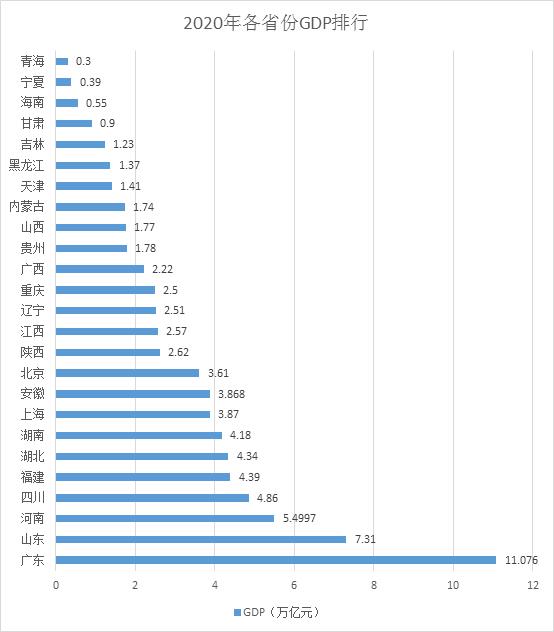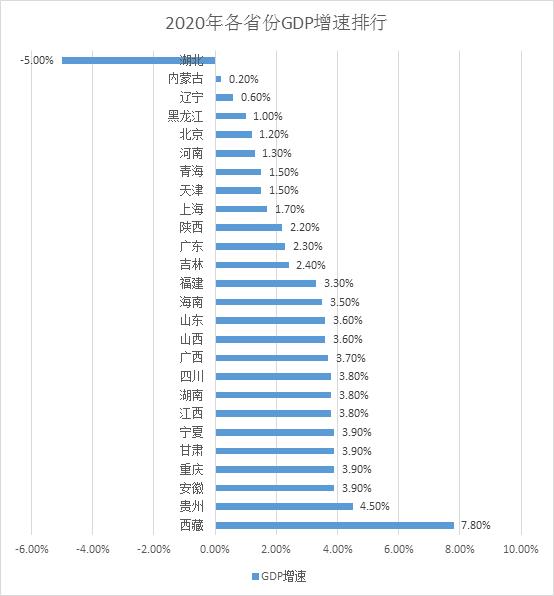Annual Economic Reports of 26 Provinces: Guangdong surpassed 11 trillion yuan, surpassing Russia and South Korea.
As of January 25th, except Jiangsu, Zhejiang, Hebei, Yunnan, and Xinjiang, 26 provinces in China have handed in the 2020 economic answer sheet.
Judging from the total economic output in 2020, among the 26 provinces, the total economic output of 21 provinces exceeds 1 trillion yuan. Guangdong has been ranked first in the country for 32 consecutive years. Last year, the total economic output exceeded the 11 trillion yuan mark for the first time. According to the data of the World Bank, this data also surpassed the total economic output of Russia and South Korea in 2019, followed by Canada.
Judging from the economic growth rate in 2020, among the 26 provinces, the economic growth rate of 16 provinces exceeds or is equal to the national performance. The central and western regions remain in the lead. In 2020, Tibet’s GDP growth rate will lead the whole country, with an annual economic growth of 7.8%.
In 2020, the regional GDP of Hubei Province was 4.34 trillion yuan, down 5.0% from the previous year, and the decline was 34.2 percentage points narrower than that in the first quarter. From "pressing the pause" in the first quarter to "restarting the recovery" in the second quarter, and then "accelerating the overall recovery" in the second half of the year, Hubei withstood the huge impact of the "pause" for 76 days, and the economy recovered and developed well in the face of enormous difficulties and challenges throughout the year.
Guangdong’s total output exceeds 11 trillion yuan, ranking first in the country for 32 consecutive years.
From the perspective of the economic aggregate in 2020, Guangdong has no suspense to reach the top of the list again. The annual economic aggregate exceeded 11 trillion yuan, ranking first in the country for 32 consecutive years. The total amount even exceeds the GDP of Russia and South Korea in 2019. Considering the impact of the epidemic, China is the only major economy that has achieved positive economic growth, which means that Guangdong’s GDP will definitely exceed that of Russia and South Korea in 2020.
In 2020, the regional GDP of Guangdong Province was 11.076 trillion yuan, a year-on-year increase of 2.3%. This economic volume can be described as "extremely rich". At present, Guangdong’s GDP in 2020 is equivalent to 1.7101 trillion US dollars.

According to the World Bank’s data on the economic aggregate of Russia and South Korea in 2019, Russia’s GDP in 2019 was 1.6999 trillion US dollars, ranking 11 th in the world; South Korea’s GDP in 2019 was 1. 6467 trillion US dollars, ranking 12th in the world. In 2020, Guangdong’s total economic output will steadily surpass that of Canada. Jiangsu, whose economic aggregate has followed Guangdong all the year round, has not yet announced its GDP in 2020. However, in 2019, the total economic output of Jiangsu approached 10 trillion yuan, and the regional GDP reached 9.96 trillion yuan, an increase of 6.1% over the previous year.
Jiangsu will undoubtedly become the second province in China with GDP exceeding 10 trillion yuan. Judging from the performance in 2020, Jiangsu’s GDP in the first quarter of last year fell by 5% year-on-year; The first half of the year increased by 0.9% year-on-year; The first three quarters increased by 2.5% year-on-year, and many indicators reached or exceeded the same period last year.
Shandong’s GDP in 2020 was 7.31 trillion yuan, a year-on-year increase of 3.6%. Followed by Henan, the GDP last year was 5.4997 trillion yuan, a year-on-year increase of 1.3%.
In 2020, there are four provinces with GDP in the "4 trillion yuan club", namely Sichuan (4.86 trillion yuan), Fujian (4.39 trillion yuan), Hubei (4.34 trillion yuan) and Hunan (4.18 trillion yuan). Among them, Hunan’s regional GDP exceeded 4 trillion yuan for the first time last year, up 3.8% year-on-year, up 2.5 percentage points from the first half of the year.
The GDP of Shanghai, Anhui and Beijing exceeded 3 trillion yuan in 2020, and the GDP of Shaanxi, Jiangxi, Liaoning, Chongqing and Guangxi was in the array of 2 trillion yuan last year. Last year, GDP exceeded 1 trillion yuan, including Guizhou, Shanxi, Inner Mongolia, Tianjin, Heilongjiang and Jilin provinces.
The economic growth rate of 16 provinces surpassed or equaled the national results.
According to preliminary accounting, in 2020, China’s GDP will be 101,598.6 billion yuan, an increase of 2.3% over the previous year at comparable prices. Quarterly, it decreased by 6.8% in the first quarter, increased by 3.2% in the second quarter, increased by 4.9% in the third quarter and increased by 6.5% in the fourth quarter.

Among the 26 provinces, the economic growth rate of Tibet, Guizhou, Anhui, Chongqing, Gansu, Ningxia, Jiangxi, Hunan, Sichuan, Guangxi, Shanxi, Shandong, Hainan, Fujian, Jilin and Guangdong in 2020 exceeded or was equal to the national achievement. The central and western regions remain in the lead. In 2020, Tibet’s GDP growth rate will lead the country. Last year, the gross domestic product of Tibet exceeded 190 billion yuan, and the annual economic growth was 7.8%.
Guizhou followed closely, with GDP of 1.78 trillion yuan in 2020, up 4.5% year-on-year, and the growth rate was 2.2 percentage points higher than that of the whole country, ranking among the top in the country for 10 consecutive years.
The GDP growth rates of Anhui, Chongqing, Gansu and Ningxia were all 3.9% last year, while those of Jiangxi, Hunan and Sichuan were all 3.8%. Last year, Guangxi, Shanxi, Shandong, Hainan and Fujian also had economic growth rates exceeding 3%.
The GDP growth rates of Liaoning, Inner Mongolia and Hubei provinces are temporarily ranked at the bottom. Among them, Liaoning’s GDP last year was 2.51 trillion yuan, a year-on-year increase of 0.6%; Inner Mongolia’s total economic output last year was 1.74 trillion yuan, a year-on-year increase of 0.2%.
In 2020, the regional GDP of Hubei Province was 4.34 trillion yuan, which was 5.0% lower than the previous year at comparable prices, and the decline rate was 34.2 percentage points narrower than that in the first quarter.
It is particularly noteworthy that in the first three quarters of this year, Hubei’s GDP was surpassed by Hunan all the way, but the annual economic aggregate of Hubei surpassed Hunan by 166.197 billion yuan.
From "pressing the pause" in the first quarter to "restarting the recovery" in the second quarter, and then "accelerating the overall recovery" in the second half of the year, Hubei withstood the huge impact of the "pause" for 76 days, and the economy recovered and developed well in the face of enormous difficulties and challenges throughout the year.
"Under the great epidemic, we have stabilized the basic economic disk, firmly grasped the bottom line of people’s livelihood, nurtured development opportunities, and made painstaking efforts." Hubei Provincial Bureau of Statistics said that Hubei handed over a better-than-expected and precious heroic answer sheet.